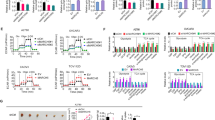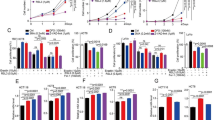Abstract
Malic enzyme 1 (ME1) links the glycolytic and citric acid cycles and is important for NADPH production, glutamine metabolism, and lipogenesis. Recently, its deregulation has been implicated in the progression of various cancers. However, the role of ME1 in the progression of hepatocellular carcinoma (HCC) remains unclear. In this study, we utilized short hairpin RNA-mediated gene silencing to investigate the biological effects of ME1 depletion in HCC and determined its prognostic significance in HCC. ME1 expression was examined by real-time (RT)-PCR and Western blot using five HCC cell lines and one normal liver cell line. We used polyethylenimine nanoparticles to deliver a short hairpin RNA to induce cessation of ME1 expression in HCC cells. Changes in NADPH production and reactive oxygen species (ROS) production were studied. Metastatic potentials of HCC cells were evaluated in vitro. Furthermore, we evaluated the protein level of ME1 in para-tumor and cancerous tissues of 65 HCC patients with detailed clinical, pathological, and clinical follow-up data. Patients’ survivals were further assessed as well. Upregulated ME1 expression was observed in HCC cell lines. Downregulation of ME1 attenuated NADPH production and stimulated ROS production. Silencing ME1 was noted to inhibit migratory and invasive properties of HCC cells by inducing the E-cadherin expression and decreasing of N-cadherin and vimentin expression in a ROS-dependent pathway. Overexpression of ME1 was observed in a major fraction of HCC samples. Higher level of ME1 in tumors was significantly associated with reduced overall survival (Kaplan–Meier analysis, P = 0.024) and reduced progression-free survival (Kaplan–Meier analysis, P = 0.011). Inhibition of ME1 expression decreases HCC metastasis via suppression of epithelial–mesenchymal transition (EMT) processes in ROS-induced pathways. ME1 overexpression associates with unfavorable prognoses in patients with HCC, suggesting that ME1 is a poor prognostic predictor of hepatocellular carcinoma.




Similar content being viewed by others
References
Mazzanti R, Gramantieri L, Bolondi L. Hepatocellular carcinoma: epidemiology and clinical aspects. Mol Asp Med. 2008;29:130–43.
Hu L, Xue F, Li Y, Shao M, Sun Y, Wei G. A long-term follow-up and comprehensive observation of risk and prognosis factors of recurrence and survival after resection of hepatocellular carcinoma. Cell Biochem Biophys. 2014;69:421–31. Springer US.
Kim J-W, Dang CV. Cancer’s molecular sweet tooth and the Warburg effect. Cancer Res. 2006;66:8927–30. American Association for Cancer Research.
Chen Z, Wang Z, Guo W, Zhang Z, Zhao F, Zhao Y, et al. TRIM35 interacts with pyruvate kinase isoform M2 to suppress the Warburg effect and tumorigenicity in hepatocellular carcinoma. Oncogene. 2014.
Corominas-Faja B, Cuyàs E, Gumuzio J, Bosch-Barrera J, Leis O, Martin ÁG, et al. Chemical inhibition of acetyl-CoA carboxylase suppresses self-renewal growth of cancer stem cells. Oncotarget. 2014;5:8306–16.
Wang J, Yuan W, Chen Z, Wu S, Chen J, Ge J, et al. Overexpression of G6PD is associated with poor clinical outcome in gastric cancer. Tumour Biol. 2012;33:95–101. Springer Netherlands.
Jiang L, Xiao L, Sugiura H, Huang X, Ali A, Kuro-O M, et al. Metabolic reprogramming during TGFβ1-induced epithelial-to-mesenchymal transition. Oncogene. 2014;0.
Jiang L, Wang H, Li J, Fang X, Pan H, Yuan X, et al. Up-regulated FASN expression promotes transcoelomic metastasis of ovarian cancer cell through epithelial-mesenchymal transition. Int J Mol Sci. 2014;15:11539–54.
Wise EM, Ball EG. Malic enzyme and lipogenesis. Proc Natl Acad Sci U S A. 1964;52:1255–63.
Al-Dwairi A, Pabona JMP, Simmen RCM, Simmen FA. Cytosolic malic enzyme 1 (ME1) mediates high fat diet-induced adiposity, endocrine profile, and gastrointestinal tract proliferation-associated biomarkers in male mice. Singh SR, editor. PLoS ONE. Public Library of Science; 2012;7:e46716.
Jiang P, Du W, Mancuso A, Wellen KE, Yang X. Reciprocal regulation of p53 and malic enzymes modulates metabolism and senescence. Nature. 2013;493:689–93.
Zheng F-J, Ye H-B, Wu M-S, Lian Y-F, Qian C-N, Zeng Y-X. Repressing malic enzyme 1 redirects glucose metabolism, unbalances the redox state, and attenuates migratory and invasive abilities in nasopharyngeal carcinoma cell lines. Chin J Cancer. 2012;31:519–31.
Tang ZY, Sun FX, Tian J, Ye SL, Liu YK, Liu KD, et al. Metastatic human hepatocellular carcinoma models in nude mice and cell line with metastatic potential. World J Gastroenterol. 2001;7:597–601.
Li Y, Tang ZY, Ye SL, Liu YK, Chen J, Xue Q, et al. Establishment of cell clones with different metastatic potential from the metastatic hepatocellular carcinoma cell line MHCC97. World J Gastroenterol. 2001;7:630–6.
Pi H, Xu S, Zhang L, Guo P, Li Y, Xie J, et al. Dynamin 1-like-dependent mitochondrial fission initiates overactive mitophagy in the hepatotoxicity of cadmium. Autophagy. 2013;9:1780–800. Taylor & Francis.
Hu Y-J, Li H-Y, Qiu K-J, Li D-C, Zhou J-H, Hu Y-H, et al. Downregulation of Notch1 inhibits the invasion of human hepatocellular carcinoma HepG2 and MHCC97H cells through the regulation of PTEN and FAK. Int J Mol Med. 2014;34:1081–6. Spandidos Publications.
Sun FX, Tang ZY, Lui KD, Ye SL, Xue Q, Gao DM, et al. Establishment of a metastatic model of human hepatocellular carcinoma in nude mice via orthotopic implantation of histologically intact tissues. Int J Cancer. 1996;66:239–43. Wiley Subscription Services, Inc., A Wiley Company.
Li Y, Tang Z, Ye S, Liu Y, Chen J, Xue Q, et al. Establishment of human hepatocellular carcinoma cell line with spontaneous pulmonary metastasis through in vivo selection. Zhonghua Yi Xue Za Zhi. 2002;82:601–5.
Li Y, Tang Y, Ye L, Liu B, Liu K, Chen J, et al. Establishment of a hepatocellular carcinoma cell line with unique metastatic characteristics through in vivo selection and screening for metastasis-related genes through cDNA microarray. J Cancer Res Clin Oncol. 2003;129:43–51.
Tao Z-H, Wan J-L, Zeng L-Y, Xie L, Sun H-C, Qin L-X, et al. miR-612 suppresses the invasive-metastatic cascade in hepatocellular carcinoma. J Exp Med. 2013;210:789–803. Rockefeller Univ Press.
Xiao C-L, Tao Z-H, Guo L, Li W-W, Wan J-L, Sun H-C, et al. Isomalto oligosaccharide sulfate inhibits tumor growth and metastasis of hepatocellular carcinoma in nude mice. BMC Cancer. 2011;11:150. BioMed Central Ltd.
Jankowski A, Grinstein S. A noninvasive fluorimetric procedure for measurement of membrane potential. Quantification of the NADPH oxidase-induced depolarization in activated neutrophils. J Biol Chem. 1999;274:26098–104.
Yang Y, Parsons KK, Chi L, Malakauskas SM, Le TH. Glutathione S-transferase-micro1 regulates vascular smooth muscle cell proliferation, migration, and oxidative stress. Hypertension. 2009;54:1360–8. Lippincott Williams & Wilkins.
Zhu X-D, Zhang J-B, Zhuang P-Y, Zhu H-G, Zhang W, Xiong Y-Q, et al. High expression of macrophage colony-stimulating factor in peritumoral liver tissue is associated with poor survival after curative resection of hepatocellular carcinoma. J Clin Oncol. 2008;26:2707–16. American Society of Clinical Oncology.
Gill JL, Bishop SC, McCorquodale C, Williams JL, Wiener P. Identification of polymorphisms in the malic enzyme 1, NADP(+)-dependent, cytosolic and nuclear receptor subfamily 0, group B, member 2 genes and their associations with meat and carcass quality traits in commercial Angus cattle. Anim Genet. 2012;43:88–92. Blackwell Publishing Ltd.
Rouaud F, Romero-Perez M, Wang H, Lobysheva I, Ramassamy B, Henry E, et al. Regulation of NADPH-dependent nitric oxide and reactive oxygen species signalling in endothelial and melanoma cells by a photoactive NADPH analogue. Oncotarget. 2014;5:10650–64.
Goodridge AG, Adelman TG. Regulation of malic enzyme synthesis by insulin triiodothyronine, and glucagon in liver cells in culture. J Biol Chem. 1976;251:3027–32.
Istvan ES. Structural mechanism for statin inhibition of 3-hydroxy-3-methylglutaryl coenzyme A reductase. Am Heart J. 2002;144:S27–32.
Wang M, Sun S, Neufeld CI, Perez-Ramirez B, Xu Q. Reactive oxygen species-responsive protein modification and its intracellular delivery for targeted cancer therapy. Angew Chem Int Ed Engl. 2014;53:13444–8. WILEY‐VCH Verlag.
Liu-Smith F, Dellinger R, Meyskens FL. Updates of reactive oxygen species in melanoma etiology and progression. Arch Biochem Biophys. 2014;563C:51–5.
Wei S, Wang Y, Chai Q, Fang Q, Zhang Y, Wang J. Potential crosstalk of Ca2+−ROS-dependent mechanism involved in apoptosis of Kasumi-1 cells mediated by heme oxygenase-1 small interfering RNA. Int J Oncol. 2014;45:2373–84. Spandidos Publications.
Esmaeili MA, Farimani MM, Kiaei M. Anticancer effect of calycopterin via PI3K/Akt and MAPK signaling pathways, ROS-mediated pathway and mitochondrial dysfunction in hepatoblastoma cancer (HepG2) cells. Mol Cell Biochem. 2014;397:17–31. Springer US.
Yang M-H, Chen C-L, Chau G-Y, Chiou S-H, Su C-W, Chou T-Y, et al. Comprehensive analysis of the independent effect of twist and snail in promoting metastasis of hepatocellular carcinoma. Hepatology. 2009;50:1464–74. Wiley Subscription Services, Inc., A Wiley Company.
Li J, Dong L, Wei D, Wang X, Zhang S, Li H. Fatty acid synthase mediates the epithelial-mesenchymal transition of breast cancer cells. Int J Biol Sci. 2014;10:171–80.
Liu Y, Liu Y, Yan X, Xu Y, Luo F, Ye J, et al. HIFs enhance the migratory and neoplastic capacities of hepatocellular carcinoma cells by promoting EMT. Tumour Biol. 2014;35:8103–14. Springer Netherlands.
Das TP, Suman S, Damodaran C. Induction of reactive oxygen species generation inhibits epithelial–mesenchymal transition and promotes growth arrest in prostate cancer cells. Mol Carcinog. 2014;53:537–47.
Acknowledgments
The project was jointly supported by the National Science Foundation of China (81272437, 81472675). We thank Mengxin Tian for providing clinical data of HCC patients.
Conflicts of interest
None
Authors’ Contributions
D Wen, DL Liu, and WZ Wu conceived and designed the study. D Wen, DL Liu, J Tang, LL Dong, Y Liu, JL Wan, and ZH Tang performed the experiments including IHC, RT-PCR, Western blotting, and in vivo assays. D Wen, and DL Liu performed NADPH quantification assays. D Wen, DL Liu, and WZ Wu analyzed the data and prepared the manuscript. L Wang, HC Sun, and J Fan participated in the study design. All authors read and approved the final manuscript.
Author information
Authors and Affiliations
Corresponding author
Additional information
Duo Wen and Dongli Liu contributed equally to this work.
Rights and permissions
About this article
Cite this article
Wen, D., Liu, D., Tang, J. et al. Malic enzyme 1 induces epithelial–mesenchymal transition and indicates poor prognosis in hepatocellular carcinoma. Tumor Biol. 36, 6211–6221 (2015). https://doi.org/10.1007/s13277-015-3306-5
Received:
Accepted:
Published:
Issue Date:
DOI: https://doi.org/10.1007/s13277-015-3306-5




